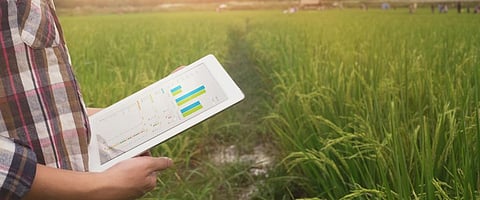How big data can boost agricultural growth
In agriculture, big data is often viewed as a combination of technology and analytics that can collect and compile novel data and process it in a more useful and timely way to assist decision making.
Data mining is the computing process of discovering patterns in large data sets involving methods at the intersection of artificial intelligence, machine learning statistics and database system.
Precision agriculture’s main objective is to ensure profitability, efficiency, and sustainability using the big data gathered to guide both immediate and future decision-making. This could cover everything — from when it is best to apply fertilizers, chemical and seeds, to from where in the field it is best to apply a rate.
According to agriculture funders, the big data practice comprises capturing relevant data from a huge number of sources, collecting it today and translating it into actionable information to improve business processes and solve problems at scale and speed.
Real-time insights to help performance optimisation advance analytics can show how farmers are utilising their inputs and what adaptations are required to take account of emerging weather events or disease outbreaks.
To achieve this, advanced algorithms are needed to swiftly unlock the highly valuable insights for products to perform well on an ongoing basis despite changing conditions. The development of highly-specific customer segmentation set has become possible to tailor product offerings to meet customer needs.
For instance, if Black Grass becomes problematic in a given region, suppliers can deploy big data techniques such as real-time micro-segmentation of customers to target promotional and marketing activities, thus facilitating better utilisation of marketing spends. Big data connectivity has proven itself a key asset for companies seeking a competitive advantage over their competitors.
Benefits include faster unearthing of valuable insights and the ability to develop and adapt products that meet specific customer needs on an ongoing basis.
Robots can play an important role in control, but it can be expected that the role of humans in analysis and planning is increasingly assisted by machines so that the cyber physical cycle becomes almost autonomous.
Considering its potential, various agri-tech companies are providing their services to the producers to make the practice more approachable and available. Hardware-wise there are various sensors collecting the available data.
In this range, we can encounter autonomous vehicle devices farmers place in the ground to measure soil moisture and nutrient, predictive weather stations and image-capturing satellites and drones mapping out land and measuring crop health.
These insights are extremely important since they tell the farmer when and how much to irrigate a field, crop health, weather predictions, pest infestations and even drought conditions. Considering the increasing labor shortages in the sector the capacity for big data analysis that lessens the need for physical manpower is of great advantage for agriculture.
Role of data analysis in agriculture
Application of science and new technologies is currently lacking within this space. Many companies and start-ups are looking to fill this information gap. If Big Data has made serious advancement in fields like information technology, healthcare, education and even sports, there is an obvious need for it in the agricultural industry too.
While the vast majority of farmers and ranchers did great work for maintaining and increasing soil health using conservation practices alone, measurement tools will be instrumental in ensuring a sustainable farming future.
To maintain yields and meet the food demands of a growing population while also protecting natural resources required, making additional changes and data tools can help determine what these changes should be.
The end result of gathering data is to analyse it and come up with actionable solutions with better results. For example, a satellite image of a plot of land has several layers of data embedded into a single spectrum giving us a tonne of information to analyse. The geospatial approach and satellite monitoring of farms have led to major advancement in how farmers and companies make their decisions.
Advantages of data analysis in agriculture
Data helps debt-laden farmers, insurance agencies, loan banks, seed companies, machine industry and every big and small player. Data analysis not only creates greater awareness and more accurate knowledge, but it can also plug the lacunae in the supply and marketing chain of the industry.
Information is power, and the industry can now have access to it for more informed decision making. These are the ways in which data analysis can help:
Development of new seed traits - Access to the plant genome with new ways to measure, map and drive information betters products.
Precision farming - Big data takes advantage of information derived through precision farming in aggregate over many farms. The resulting analytics, insights and better decisions can then be deployed through precision farming techniques
Food tracking - Use of sensors and analytics to prevent spoilage and food-borne illnesses
Effect on supply chains - Seismic shifts in the supply chain of seed, crop inputs and food driven by the democratisation of technology and information
The big data revolution is in its early days and most of the potential for value creation is still unclaimed. But it has set the industry on a path of rapid change and new discoveries. Stakeholders committed to innovation will likely be the first to reap rewards. If the farmers would have been concerned about the infirmities in terms of data-based farming, production could be increased.


